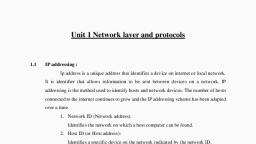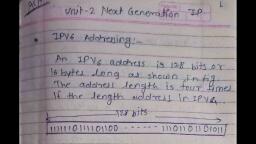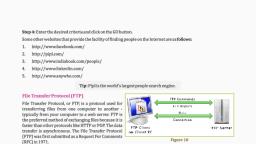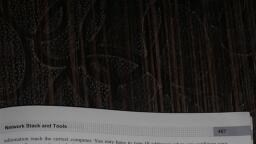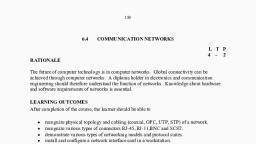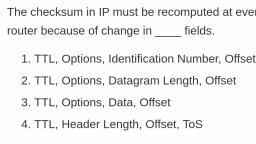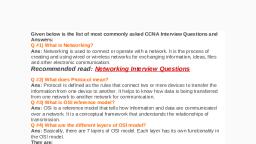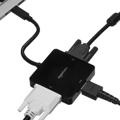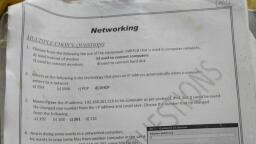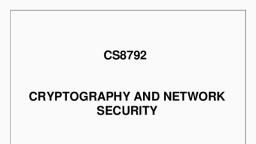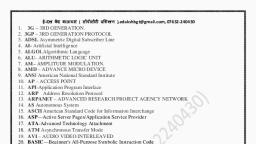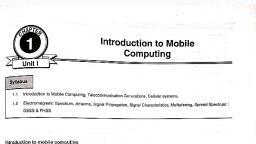Page 1 :
Maharashtra State Board of Technical Education, Mumbai, , Course Name : Diploma in Computer Engineering, Semester : Fifth (I Scheme), , Subject Name : Advanced Computer Network, , Subject Code : 22520, , Unit – II Next Generation IP (10 Marks), , Prepared By, A.K. Rathod, (M.E. C.N.E.), Lecturer in Computer Engineering, Government Polytechnic Jintur District Parbhani, , 1
Page 2 :
Unit – II Next Generation IP, Unit Outcomes (in Cognitive Domain), 2 a. Map the given IPv4 address to IPv6 address, , 2 b. Describe function of the given step in the stateless auto, configuration process., , 2 c. Outline the given strategy of transition from IPv4 to IPv6., , 2 d. Explain significance of the given field in datagram format of IPv6, , 2
Page 3 :
Unit – II Next Generation IP, , IPv6, Addressing, , 3
Page 4 :
Unit – II Next Generation IP, , Introduction, So far, IPv4 has proven itself as a robust routable addressing protocol and has, served us for decades on its best-effort-delivery mechanism. It was designed in the, early 80’s and did not get any major change afterward. At the time of its birth, Internet, was limited only to a few universities for their research and to the Department of, Defense. IPv4 is 32 bits long and offers around 4,294,967,296 (232) addresses. This, address space was considered more than enough that time., , 4
Page 5 :
Unit – II Next Generation IP, Major points that played a key role in the birth of IPv6:, Internet has grown exponentially and the address space allowed by IPv4 is saturating., There is a requirement to have a protocol that can satisfy the needs of future Internet, addresses that is expected to grow in an unexpected manner., IPv4 on its own does not provide any security feature. Data has to be encrypted with, some other security application before being sent on the Internet., Data prioritization in IPv4 is not up to date. Though IPv4 has a few bits reserved for, Type of Service or Quality of Service, but they do not provide much functionality., IPv4 enabled clients can be configured manually or they need some address, configuration mechanism. It does not have a mechanism to configure a device to have, globally unique IP address., , 5
Page 6 :
Unit – II Next Generation IP, Representation, In IPv6 representation, there are three addressing methods :, , 1.) Unicast 2.) Multicast 3.) Anycast, 1) Unicast - Unicast mode of addressing, an IPv6 interface (host) is uniquely identified, in a network segment. The IPv6 packet contains both source and destination IP, addresses. A host interface is equipped with an IP address which is unique in that, network segment. When a network switch or a router receives a unicast IP packet,, destined to a single host, it sends out one of its outgoing interface which connects to, that particular host., , Image Source:, tutorials point.com, , 6
Page 7 :
Unit – II Next Generation IP, Representation, 2) Multicast - The IPv6 multicast mode is same as that of IPv4. The packet destined to, multiple hosts is sent on a special multicast address. All the hosts interested in that, multicast information, need to join that multicast group first. All the interfaces that, joined the group receive the multicast packet and process it, while other hosts not, interested in multicast packets ignore the multicast information., , Image Source: tutorials point.com, 7
Page 8 :
Unit – II Next Generation IP, Representation, 3) Anycast - IPv6 has introduced a new type of addressing, which is called Anycast, addressing. In this addressing mode, multiple interfaces (hosts) are assigned same, Anycast IP address. When a host wishes to communicate with a host equipped with an, Anycast IP address, it sends a Unicast message. With the help of complex routing, mechanism, that Unicast message is delivered to the host closest to the Sender in terms, of Routing cost., , Image Source: tutorials point.com, 8
Page 9 :
Unit – II Next Generation IP, IPv6 Address Space, IPv6 was developed by Internet Engineering Task Force (IETF) to deal with the, problem of IPv4 exhaustion. IPv6 is 128-bits address having an address space of 2128,, which is way bigger than IPv4. This number, when expanded out, is, 340,282,366,920,938,463,463,374,607,431,768,211,456, which is normally expressed, in, , scientific, , notation, , as, , about, , 3.4*1038, , addresses., , That's, , about, , 340, , trillion, trillion, trillion addresses. It is pretty hard to grasp just how large this number, is. In IPv6 we use Colon-Hexa representation. There are 8 groups and each group, represents 2 Bytes., Example, , ABCD : EF01 : 2345 : 6789 : ABCD : B201 : 5482 : D023, 16 Bytes, 9
Page 10 :
Unit – II Next Generation IP, Address Structure, An IPv6 address is made of 128 bits divided into eight 16-bits blocks. Each, block is then converted into 4-digit Hexadecimal numbers separated by colon symbols., For example, given below is a 128 bit IPv6 address represented in binary format and, divided into eight 16-bits blocks:, , 0010000000000001 0000000000000000 0011001000111000 1101111111100001, 0000000001100011 0000000000000000 0000000000000000 1111111011111011, , Each block is then converted into Hexadecimal and separated by ‘:’ symbol:, 2001:0000:3238:DFE1:0063:0000:0000:FEFB, Even after converting into Hexadecimal format, IPv6 address remains long. IPv6, provides some rules to shorten the address. The rules are as follows:, 10
Page 11 :
Unit – II Next Generation IP, Address Structure, The rules are as follows:, Rule.1: Discard leading Zero(es):, In Block 5, 0063, the leading two 0s can be omitted, such as (5th block):, 2001:0000:3238:DFE1:63:0000:0000:FEFB, Rule.2: If two of more blocks contain consecutive zeroes, omit them all and replace, with double colon sign ::, such as (6th and 7th block):, 2001:0000:3238:DFE1:63::FEFB, Consecutive blocks of zeroes can be replaced only once by :: so if there are still blocks, of zeroes in the address, they can be shrunk down to a single zero, such as (2nd block):, 2001:0:3238:DFE1:63::FEFB, 11
Page 12 :
Unit – II Next Generation IP, Address Space allocation, Address space allocation in IPv6 is a process which divides the address space of IPv6, in several blocks. Each block is allocated for some special purpose and has a different, size., Most of the blocks in IPv6 are not assigned yet and will be used in future., The entire address space in IPv6 has been divided in to eight equal ranges. As shown, below., 1/8, Reserved, Assigned, , 1/8, Global, Unicast, , 1/8, Reserved, , 1/8, Reserved, , 1/8, Reserved, , 1/8, Reserved, , 1/8, Reserved, , 1/8, Reserved, Assigned, , Address Space = 2128 addresses, Fig – A Address Space allocation in IPv6, As shown in above figure, the number of addresses in each section is one eighth of the, total addresses in each section is equal to 2125 addresses, 12
Page 13 :
Unit – II Next Generation IP, Address Space allocation, The First Section : The first section is marked as Reserved / Assigned as shown in fig. A, that means some address block in this sections are reserved and the remaining are, assigned as shown in Fig.- B, Reserved / Assigned, , A, , B, , C, , D, , E, , F, , A: 1/256 IPv4 Compatible, , D: 1/64 Reserved, , B: 1/256 Reserved, , E: 1/32 Reserved, , C: 1/128 Reserved, , F: 1/16 Reserved, Fig.-B The First Section, , As shown in fig , the first section is divided in six blocks of variable size (Block A to F)., Out of these six blocks, three blocks have been reserved and remaining three are not, assigned., 13
Page 14 :
Unit – II Next Generation IP, Address Space allocation, The Second Section : The Second Section is not divided in to blocks. So it is considered, as one single block and is used for the global unicast addresses., , Section Three to Seven : These five sections from third to seven are unassigned., , The Last Section : The last section in fig-A, which is marked as Reserved / Assigned is, further divided into eight blocks of different sizes as shown in Fig.C., Some of these blocks are not assigned while the other blocks are reserved for some, special purpose as shown in fig. C, , 14
Page 15 :
Unit – II Next Generation IP, Address Space allocation, Last Section (1/8), Reserved / Assigned, , G, , H, , I, , J, , K, , L, , M, , N, , A: 1/256 IPv4 Compatible, , D: 1/64 Reserved, , B: 1/256 Reserved, , E: 1/32 Reserved, , C: 1/128 Reserved, , F: 1/16 Reserved, Fig.-B The First Section, , Out of the total address space of IPv6 more than 5/8th of the space is still not assigned,, and only 1/8th of the address space has been assigned for the global unicast addresses for, unicast communication between the users., 15
Page 16 :
Unit – II Next Generation IP, Autoconfiguration, Autoconfiguration is one of the most interesting feature of IPv6 addressing., In IPv6 we can either use DHCP protocol for allocating the IPv6 address to host or, host can configure itself. This process of self configuration of a host is called, autoconfiguration. Autoconfiguration process of a host is done in following steps., 1. The Link Local Address is first created by host for itself. This is done by following, stepwise procedure., a) Take the 10 bit link local prefix (1111 1110 10), b) Add 54 zeros to it., c) Add 64 bit interface identifier which any host can generate from its NIC., After this we get 128 bit link local address., 16
Page 17 :
Unit – II Next Generation IP, Autoconfiguration, 2. The host then checks for the uniqueness of the link local address. The 64 bit, interface identifier also should be unique. To ensure this a neighbor solicitation, message is sent by the host. Then it waits for neighbor advertisement message. The, process of autoconfiguration fails if any host in the subnet is using the same link, local address. Then the host should use DHCP protocol to configure itself., 3. If the link local address is found to be unique, the host will store this address as its, link local address for private communication. But it still requires global unicast, address. Therefore router solicitation message is sent out by the host to a local, router. If there is router running on this network, then the host will receive router, advertisement message., , 17
Page 18 :
Unit – II Next Generation IP, Autoconfiguration, This message contains the global unicast prefix and subnet prefix. The host, adds these two pieces of information to its interface identifier and generates its global, unicast address. However if it is not possible of router to help the host with the, configuration, then router informs the host via router advertisement message. In such, situation the host needs to use some other means of its configuration, , 18
Page 19 :
Unit – II Next Generation IP, Renumbering, • In IPv6 the facility of renumbering the address prefix (value of n) is given which, allows sites to changes the service provider., • The service provider gives a prefix number to each site to which it is connected., Therefore the site has to change the prefix number if it has to change the service, provider., • A router to which site is connected can advertise a new prefix. The site is allowed, to use its old prefix for sometime before it is finally disabled. This means that a site, uses two prefix during the transition period., • However the problem in using this renumbering mechanism is that it needs support, of DNS., • To overcome this problem a new DNS protocol called New generation DNS is used, which supports the renumbering mechanism., 19
Page 20 :
Unit – II Next Generation IP, Comparison between IPv4 & IPv6, Sr No., , IPv4, , IPv6, , 01, , IPv4 has 32-bit address length, , IPv6 has 128-bit address length, , 02, , It Supports Manual and DHCP address, , It supports Auto and renumbering, , configuration, , address configuration, , 03, , In IPv4 end to end connection integrity In IPv6 end to end connection, is Unachievable, , 04, , integrity is Achievable, , It can generate 4.29×109 address space Address space of IPv6 is quite large it, can produce 3.4×1038 address space, , 05, , 06, , Security feature is dependent on, , IPSEC is inbuilt security feature in the, , application, , IPv6 protocol, , Address representation of IPv4 in, , Address Representation of IPv6 is in, , decimal, , hexadecimal, 20
Page 21 :
Unit – II Next Generation IP, Comparison between IPv4 & IPv6, Sr No., 07, , 08, , IPv4, , IPv6, , Fragmentation performed by Sender, , In IPv6 fragmentation performed only, , and forwarding routers, , by sender, , In IPv4 Packet flow identification is not In IPv6 packet flow identification are, available, , Available and uses flow label field in, the header, , 09, , In IPv4 checksum field is available, , 10, , It has broadcast Message Transmission In IPv6 multicast and any cast, Scheme, , In IPv6 checksum field is not available, , message transmission scheme is, available, , 11, , 12, , In IPv4 Encryption and Authentication, , In IPv6 Encryption and Authentication, , facility not provided, , are provided, , IPv4 has header of 20-60 bytes., , IPv6 has header of 40 bytes fixed, , 21
Page 22 :
Unit – II Next Generation IP, , Transition from, IPv4 to IPv6, , 22
Page 23 :
Unit – II Next Generation IP, Transition from IPv4 to IPv6, • The rationale for transition is either the lack of IPv4 address space or the required, use of new features in IPv6, or both. The IPv6 specification requires 100 per cent, compatibility for the existing protocols. Compatibility is also required for existing, applications during the transition., • As there are large number of systems on the internet, the transition from IPv4 to, IPv6 can not happen suddenly., • It takes a considerable amount of time before every system in the internet can move, from IPv4 to IPv6. The transition must be smooth to prevent any problems between, IPv4 and IPv6 systems., • Three strategies have been devised by the IETF to help the transition as shown in, figure X below., , Dual Stack, , Transition Strategies, , Tunneling, , Fig.-X Three Transition Strategies, , Header Translation, 23
Page 24 :
Unit – II Next Generation IP, Transition from IPv4 to IPv6, Dual Stack : In This strategy, it is recommended that all hosts, before migrating, completely to version 6, have a dual stack of protocols. In other words, a station must, run IPv4 and IPv6 simultaneously until all the internet uses IPv6. Following Figure P, shows a layout of dual stack configuration., Transport and Application Layers, IPv4, , IPv6, , Underlying LAN or WAN technology, , To IPv4 System, , Fig.-P Dual Stack, , To IPv6 System, , To determine which version to use when sending a packet to a destination, the source, host queries the DNS. If the DNS returns an IPv4 address, the source host sends an, IPv4 packet. If the DNS returns an IPv6 address, the source host sends an IPv6 packet., 24
Page 25 :
Unit – II Next Generation IP, Transition from IPv4 to IPv6, Tunneling: Tunneling is a strategy used when two computers using IPv6 want to, communicate with each other and the packet must pass through a network that uses IPv4., Now to pass through this network, the packet must have an IPv4 address. So the IPv6, packet is encapsulate in an IPv4 packet when it enter into the IPv4 network, and it leaves, its capsule when it exits the IPv4 network. That means an IPv6 packet goes through a, tunnel at one end and emerges out at other end. This process is called as tunneling. While, IPv4 packet is carrying an IPv6 packet data, the protocol value is set to 41. tunneling is, shown in figure. Q, , IPv4 Header, IPv6 Header, Payload, , IPv6 Header, , Tunnel, , Payload, , IPv6, Host, , IPv6 Header, Payload, , IPv4 Network, , Figure-Q Tunneling Strategy, , IPv6, Host, 25
Page 26 :
Unit – II Next Generation IP, Transition from IPv4 to IPv6, Header Translation: Header Translation is necessary when the majority of the internet, has moved to IPv6 but some systems still use IPv4. The sender wants to use the IPv6, but, the receiver does not understand IPv6. Tunneling does not work in this situation because, the packet must be in IPv4 format to be understood by the receiver. In this case, the, header format must be totally changed through header translation. The header of IPv6, packet is converted to an IPv4 header. Header translation uses the mapped address to, translate an IPv6 address to an IPv4 address. Figure-R shows Header Translation., , IPv6, Host, , IPv6 Header, , IPv6 Header, , IPv4 Header, , Payload, , Payload, , Payload, , IPv4 Network, Header Translation, Done Here, , IPv6, Host, , Figure-R Header Translation Strategy, 26
Page 27 :
Unit – II Next Generation IP, Transition from IPv4 to IPv6, Header Translation Procedure:, 1. The IPv6 mapped address is changed to an IPv4 address by extracting the rightmost, 32 bits., 2. The value of IPv6 priority field is discarded., 3. The type of service field in IPv4 is set to zero., 4. The checksum for IPv4 is calculated and inserted in the corresponding field., 5. The IPv6 flow label is ignored., 6. Compatible extension headers are converted to options and inserted in the IPv4, header. Some may have to be dropped., 7. The length of IPv4 header is calculated and inserted in to corresponding field., 8. The total length of the IPv4 packet is calculated and inserted in the corresponding, field., , 27
Page 28 :
Unit – II Next Generation IP, , IPv6 Protocol, , 28
Page 29 :
Unit – II Next Generation IP, Advantages of IPv6 over IPv4, 1. Larger Address Space – An Ipv6 address is 128 bit long as compared with 32-bit, address of IPv4, this is huge increase in (296)the address space of IPv6., 2. Better Header Format – IPv6 uses a new header format in which options are, separated from base header and inserted, when needed, between the base header and, upper layer data. This will simplify and speedup the routing process because most of, the options do not need to be checked by the routers., 3. New Options – IPv6 has new options to allow for additional functionalities., 4. Allowance for extension – IPv6 is designed to allow the extension of protocol if, required by new technologies or applications., , 29
Page 30 :
Unit – II Next Generation IP, Advantages of IPv6 over IPv4, 5. Support for resource allocation – in IPv6, the type of service field has been, removed, but a mechanism called label flow has been added to enable source to, request special handling of the packet. This mechanism can be used to support traffic, such as real time audio and video., 6. Supports for more security – The encryption and authentication options in IPv6, provide confidentiality and integrity of the packet., 7. Auto-configuration - IPv6 supports both stateful and stateless auto configuration, mode of its host devices. This way, absence of a DHCP server does not put a halt on, inter segment communication., 8. Anycast Support - This is another characteristic of IPv6. IPv6 has introduced, Anycast mode of packet routing. In this mode, multiple interfaces over the Internet, are assigned same Anycast IP address. Routers, while routing, send the packet to the, nearest destination., 30
Page 31 :
Unit – II Next Generation IP, IPv6 Packet Format, The Ipv6 packet format is shown in figure-M. each packet is composed of a, mandatory base header followed by the payload., The payload consists of two parts: optional extension headers and data from an upper, layer., The base header occupies 40 bytes, whereas the extension headers and data from, upper layer contain up to 65,535 bytes of information., 40 Bytes, Base Header, , Payload, , Extension Headers, (Optional), , Data Packet from upper layer, , Figure-M, IPv6 Datagram header and payload, 31
Page 32 :
Unit – II Next Generation IP, IPv6 Packet Format, Base Header : Figure-N shows the base header, the IPv6 base header has eight fields., Functions of each field is given below., , Figure-N, IPv6 Datagram Base header Format, 32
Page 33 :
Unit – II Next Generation IP, IPv6 Packet Format, Base Header :, Version – This 4 bit field defines the version number of the IP. For IPv6, the value is 6., Priority – The priority field of IPv6 packet defines the priority of each packet with, respect o other packets from the same source. For example if one of two consecutive, datagrams must be discarded due to congestion, the datagram with lower priority will be, discarded. IPv6 divides the traffic in to two broad categories : Congestion –controlled and, non-congestion controlled traffic., Priorities for Congestion Controlled Traffic -, , 33
Page 34 :
Unit – II Next Generation IP, IPv6 Packet Format, Priorities for Non Congestion Controlled Traffic -, , Flow Label – The flow label is a 3 byte (24 bit) field that is designed to provide special, handling for a particular flow of a data., Payload Length – The 2 byte payload length field defines the length of the IP datagram, excluding the header., Next Header – The next header is an 8-bit field defining the header that follows the base, header in the datagram. The next header is either one of the optional extension headers, used by IP or the header of an encapsulated packet such as Udp or TCP. Each extension, also contains this field. Following figure shows the values of next header. In IPv4 this, field is protocol., , 34
Page 35 :
Unit – II Next Generation IP, IPv6 Packet Format, Base Header :, , Hop Limit – This 8 bit hop limit field serves the same purpose as the TTL field in IPv4, i.e. it controls the maximum number of routers visited by datagram during its lifetime., 35
Page 36 :
Unit – II Next Generation IP, IPv6 Packet Format, Base Header :, Source Address – The source address field is 16 byte (128 bit) internet address that, identifies the original source of a datagram., Destination Address - The destination address field is 16 byte (128 bit) internet address, that identifies the final destination of a datagram. However if source routing is used, this, field contains the address of next router., , 36
Page 37 :
Unit – II Next Generation IP, Extension Headers, The length of base header is fixed at 40 bytes. However to give greater, functionalities to the IP datagram, the base header can be followed by up to six extension, headers. Many of these headers are options in IPv4. figure-R shows six types of extension, headers., , figure-R Extension Headers., 37
Page 38 :
Unit – II Next Generation IP, Extension Headers, Hop by Hop option – The hop by hop option is used when the source needs to pass, information to all routers visited by the datagram. So far, only three options have been, defined : Pad1, Pad N and Jumbo Payload. The Pad1 option is 1 byte long and is, designed for alignment purposes. Pad N is similar in concept to Pad 1. the difference is, that Pad N is used when 2 or more bytes is needed for alignment. The jumbo payload, option is used to define a payload longer than 65,535 bytes., Source Routing – The source routing extension header combines the concepts of the, strict source route and the loose source options in IPv4, Fragmentation – The concept of fragmentation is same as that in IPv4. However the, place where fragmentation occurs differs. In IPv4, the source or a router is required to, fragment if the size of the datagram is larger than the MTU of the network over which the, datagram travels. In IPv6, only the original source can fragment. A source must use a path, MTU discovery technique to find the smallest MTU supported by any network on the, path. The source then fragment's using this knowledge., , 38
Page 39 :
Unit – II Next Generation IP, Extension Headers, Authentication – This extension header has a dual purpose: it validates the message, sender and ensures the integrity of data., Encrypted Security Payload – This extension header provides confidentiality and, guards against eavesdropping., Destination Option – This extension header is used when the source needs to pass, information to the destination only. Intermediate routers are not permitted access to this, information., , 39
Page 40 :
Unit – II Next Generation IP, , 40







